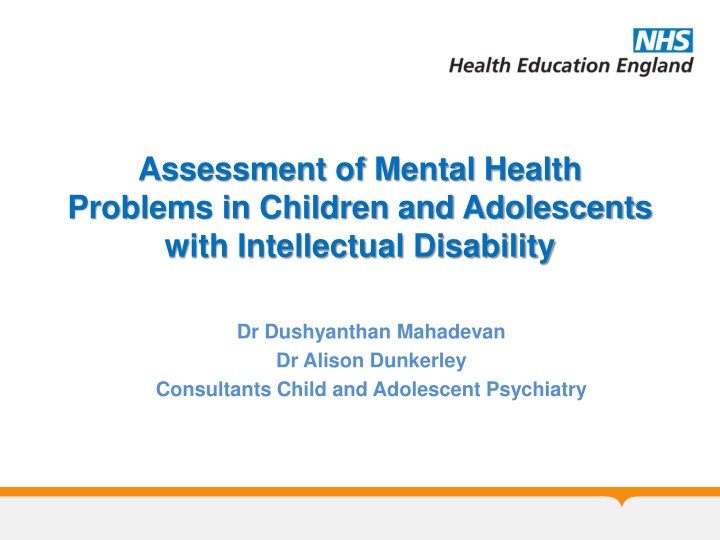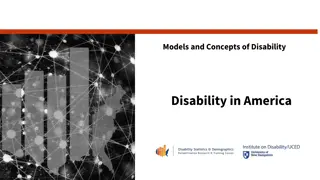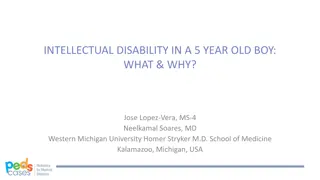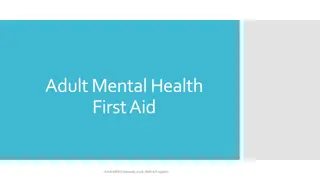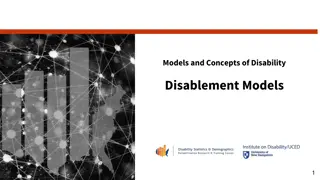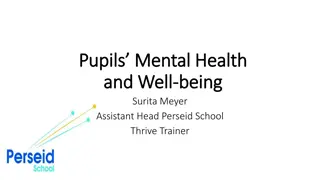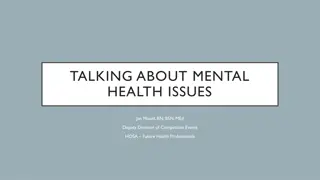Assessment of Mental Health in Children with Intellectual Disability
This article discusses the assessment of mental health problems in children and adolescents with intellectual disability, highlighting the prevalence of emotional and behavioral disorders, key differences in assessing children with intellectual disability, and the roles of various professionals in mental health assessment.
Download Presentation

Please find below an Image/Link to download the presentation.
The content on the website is provided AS IS for your information and personal use only. It may not be sold, licensed, or shared on other websites without obtaining consent from the author.If you encounter any issues during the download, it is possible that the publisher has removed the file from their server.
You are allowed to download the files provided on this website for personal or commercial use, subject to the condition that they are used lawfully. All files are the property of their respective owners.
The content on the website is provided AS IS for your information and personal use only. It may not be sold, licensed, or shared on other websites without obtaining consent from the author.
E N D
Presentation Transcript
Assessment of Mental Health Problems in Children and Adolescents with Intellectual Disability Dr Dushyanthan Mahadevan Dr Alison Dunkerley Consultants Child and Adolescent Psychiatry
Epidemiology Emotional & behavioural disorders more common in children with a Learning Disability (Rutter et al, 1970) 36% with LD have diagnosable psychiatric disorder (Emerson & Hatton 2007) 25.1% disruptive behaviour, 21.9% anxiety disorder, 4.4% mood disorder (Dekker & Koot 2003)
Discussion What is an Intellectual Disability? Is it the same as a Learning Disability? Or learning difficulties? What do you think are the key differences in assessing children (as opposed to adults) with ID and mental health problems?
Definition Intellectual disability (Rutter 2015) A global and persistent reduction in cognitive abilities beginning early in development and associated with impairment in daily functioning including communication, social skills, personal independence and school/work functioning Classification systems distinguish levels of severity based on measured IQ and degree of impairment in adaptive functioning
Objectives Assessment Introduction to management The value of the MDT and other agencies Limits of the evidence-base Principles and challenges of work in this area
Outline of presentation Role of professionals Principles of psychiatric assessment and the identification of aetiological factors Principles of psychiatric intervention Common co-morbid disorders in this population Challenging behaviour (NICE) Contexts of care
Discussion Which Professionals may play a role in mental health assessment What skills to they bring to the assessment?
Professionals Psychiatrist: assessment, diagnosis, prescribing, physical health, MHA Psychologist: (Educational/Clinical) neuropsychological testing, behavioural analysis, talking therapies Social Worker: safeguarding, placement, activities, vulnerabilities, respite care Nurses/MHP: (LD, Children s, Mental Health nurses) assess, case manage, behavioural interventions, lead groups, prescribe Occupational Therapist: everyday functioning, skills and abilities, co-ordination, sensory profile Speech and Language Therapist: assess communication skills, therapeutic work, ASD
History Taking Background information from other agencies Gauge developmental level of child Multiple informants Presenting complaint (precipitants?) Elicit details to support (or refute) hypotheses Family history: ID, epilepsy, psychiatric diagnoses Developmental history: birth, milestones Personal history: trauma, education, EHCP Risk & forensic history: self & others
Mental State Examination Child-friendly setting with toys, books (though consider safety) Enquire about emotionally neutral topics Sufficient time allowed, longer to understand Careful observation of child Physical appearance Abilities and activity levels Communication and interaction with others
Investigations Physical examination Blood tests (screening and monitoring) where possible Genetic testing (microassays) Liaison with Paediatrics re: further tests Analysis of behaviour Multi-agency approaches in various settings Synthesis of information to inform care plans
Assessment of systems around the child Families Specialist education (Ed. Psych, school observations, school clinics) Children s Social Care Paediatric teams Third sector (respite, parent groups)
Standardised Assessments WISC-IV generates profile of performance ADI-R and ADOS Conners and Qb Limits of validity in the ID population ABC (Aberrant Behaviour Checklist) DBC (Developmental Behaviour Checklist)
Aetiological Factors Demographic Factors Male gender, low socio-economic status, living with one parent, living in an institution Other Psychosocial Factors Self-esteem, ability to access activities, abuse, consistency of care, health of carers Biological Factors Decreasing IQ, epilepsy, specific genetic syndrome, sensory impairment, communication difficulties
Specific Genetic Syndromes Prader-Willi: mood lability, sleep Williams: superficial language Fragile X: aggression, anxiety Rett Syndrome: hand movements, regression Down Syndrome: behaviour Smith-Magenis: sleep, behaviour Foetal Alcohol: executive function Velo-cardio-facial: psychosis
General Approaches Help families understand the diagnosis Understand the family s beliefs Support in coming to terms with disability, and then additional disorder Advocate for developmentally appropriate care and supervision Offer realistic hope Motivate others to change their approach Keep the child central in complex multi-agency care
Interventions Preventative Skills training Functional Communication Training Behavioural Parent groups Individual (based on functional analysis) Adapted psychotherapies (e.g. CBT) Autism-specific approaches (e.g. ABA)
Pharmacological Interventions Often don t meet formal diagnostic criteria Used in combination with other approaches Specify treatment targets Monitor for adverse effects Watch for altered seizure thresholds Extrapolation from the generic evidence-base Off-licence prescribing common
Self-injurious Behaviour Functional analysis Behavioural, environmental and psychosocial interventions Treatment of comorbid conditions Treatment targets should be realistic Historically, antipsychotic drugs widely used SSRIs can be used, especially in context of anxiety/depression Naltrexone limited evidence
ADHD Assess in context of developmental level Other causes of hyperactivity (sensory sensitivities or anxiety) Structured tools (interpret with caution) ID, ASD & ADHD often cluster Associations with behavioural disorders Range of evidence-based medications
ASD Common in ID affecting up to 50% of YP May be difficult to diagnose in severe ID Difficulties describing emotions/symptoms Assess in context of overall development Structured, multi-agency assessments Paediatric assessment may be indicated
Anxiety Disorders Anxiety disorders in 10-12% Can use tools (e.g. Spence) to track symptoms Environmental modification and cognitive/behavioural approaches useful Generally do not require psychopharmacology Role of SSRIs in supporting interventions (often Fluoxetine/Sertraline)
Affective Disorders Again subjective reporting of symptoms may be limited Tools may support (diaries, MFQ) Analysis of collateral reports and risk Psychological and social approaches Medication can be beneficial (SSRIs in depression) Bipolar disorder under-recognised in ID (adult literature)
Tics Tics common in young people with ID Involuntary tics vs. stereotyped movements Associated with OCD & ADHD Diaries across multiple settings useful Interference with daily functioning, pain Antipsychotics most commonly used Clonidine can be useful with co-morbid ADHD
Schizophrenia & other Psychoses Auditory hallucinations, delusions, withdrawal Difficult to diagnose in severe ID Based on carer information & observation Important differential is self-talk seen in ID Increase in soft neurological signs & epilepsy Good therapeutic responses to antipsychotics
Sleep Disorders Common in children with learning disabilities Sleep hygiene and diaries Melatonin preparations Rectification of sleep-wake cycle interference Duration of treatment is variable
Challenging Behaviour (NICE) RCPsych definition (2007) Behaviour of such an intensity, frequency or duration as to threaten the quality of life and/or the physical safety of the individual or others and is likely to lead to responses that are restrictive, aversive or result in exclusion. Work with person & carers Understand function of behaviour Work in least restrictive way possible
General Principles of Care Clear focus on person, family & carers Interventions delivered in least restrictive setting Prompt & co-ordinated access to specialist services Staff training in strategies to reduce risk & manage behaviour Recognise impact on family/carers & consider support/groups etc. Strategies for early identification Annual physical health checks
Maintaining Processes Impact Vulnerabilities Pain Biological sensory/physical health/genetic Exclusion, harm to self, harm to others Challenging Behaviour Other people s behaviour Psychosocial life events, communication, social networks, meaningful activity, psychiatric
Assessment of Challenging Behaviour Person-centred with focus on outcomes & improving quality of life (resilience/resources) Regular review of self-harm/harm to others/ breakdown of family/abuse/escalation Functional assessment varied in complexity & intensity in line with behaviour that challenge Initial screening using MH assessment tools if MH problem might underlie behaviour
Interventions for Challenging Behaviour Parent training programmes for under 12s Functional assessment of behaviour Positive Behaviour Support Antipsychotic drugs only in combination with other interventions if Psychological interventions don t produce change Treatment for co-existing problems not reduced behaviour Risk to person or others is severe Monitoring requirements Guidance on choosing medication (often Risperidone, Aripiprazole)
Reading: Challenging Behaviour Challenging behaviour and learning disabilities: prevention and interventions for people with learning disabilities whose behaviour challenge NICE guidelines [NG11] Emerson E, Bromley J. The form and function of challenging behaviours. Journal of Intellectual Disability Research. 1995;39:388-98
Mental Health Act LD & no other form of mental disorder: may not be detained unless accompanied by abnormally aggressive or seriously irresponsible conduct Possible for ASD without mental disorder or behaviour (unlikely) LD defined as:- a state of arrested or incomplete development of the mind which includes significant impairment of intelligence & social functioning
Medicolegal issues Capacity to agree to admission? Parent can consent to admission, under 16yo Lack capacity, admitted in best interests and not Deprivation of Liberty (use MHA under 18) Risk to patient or public History of non-compliance with treatment Consent/capacity fluctuating
Equality Act & Reasonable Adjustments Communication support Information in an accessible format Sufficient time for preparation before meeting Adapted treatment programmes Adapted therapeutic environment Risk assessment of personal safety Prioritised access/involvement of carers
In-patient Facilities Assessment/diagnosis/treatment Outreach work can shorten/eliminate admission Close liaison between in-patient/local teams Clear, integrated pathway of care incl. discharge Hard to achieve if geographically distant
Community Service Models Increased prevalence of mental disorder Requiring a different type of care Development of Specialist CAMHS for ID Inclusion agenda, all able to access facilities Person-centred planning & circles of support Gaps in provision Challenges in multi-agency working
Multi-agency Working Different professional cultures Inappropriate expectations Challenges in communication Learning from different perspectives Complementing each other s practice Joining up packages of care Seeking opportunities for collaboration
Policy Context Healthy Lives, Brighter Futures (DoH 2009) Winterbourne View (DoH 2012) Future in Mind (MHT 2015) Challenging Behaviour & LD (NICE 2015) Paving The Way (CBF 2015) Transforming Care (NHS England 2015)
Summary No effective treatments for the core cognitive deficits of ID Focus on appropriate education and support for affected individuals and their families that maximize quality of life and community participation Treatment planning should be multi disciplinary and multi agency The limited evidence base for treating psychiatric disorders in ID supports the use of similar interventions, although effect sizes may be diminished Pharmacotherapy should involve lower starting doses, more gradual increases and careful monitoring, as people with ID are more sensitive to adverse effects
Summary Psychological interventions should utilize behavioural strategies, supported with visual materials and the involvement of parents/carers and other professionals such as teachers Family wide support and respite care from voluntary groups and social services may be invaluable
MCQs 1. People with intellectual disability have previously been classified as: A. Mentally retarded B. Learning disabled C. Sub-normals D. Imbeciles E. All of the above
Answer E
2. Intellectual disabilities are defined by which 3 core criteria? A. Lower intellectual ability B. Onset during childhood C. Onset before the age of 8 D. Significant impairment of social or adaptive functioning E. IQ scores are not fixed throughout life
3. Which of the following are generally accepted ranges (ICD-10, DSM-IV) for severity of ID (choose 4)? A. Mild (IQ 50-70) B. Mild (IQ 70-90) C. Moderate (IQ 50-70) D. Moderate (IQ 35-50) E. Severe (IQ 20-35) F. Severe (IQ 25-50) G. Profound (IQ below 25) H. Profound (IQ below 20)
4. Which of the following 2 statements are true? A. Mild ID accounts for approximately 80% of children with ID. B. Approximately 50% of children with ID have moderate severity. C. Severe ID accounts for approximately 7% of the ID group. D. Profound ID affects 10% of children with ID.
5. The prevalence and incidence of ID varies according to gender, age, ethnicity and socioeconomic circumstances. Which statement is false? A. Studies generally report a female predominance in LD B. Increased maternal age is likely to lead to an increase in incidence of LD C. Ethnicity influences prevalence and incidence levels in ID due to the associated links with poverty, access to healthcare, and communications barriers amongst other factors D. Lower socioeconomic position is associated with higher prevalence of mild and moderate LD, but not severe LD.
